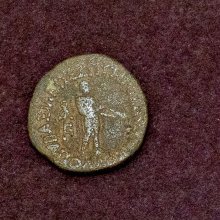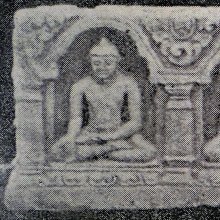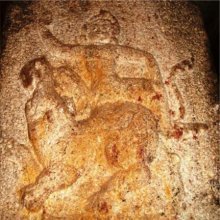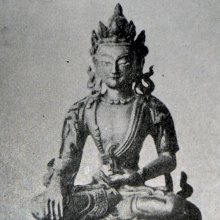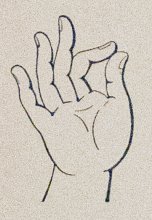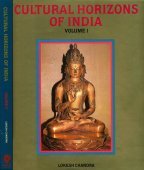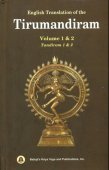Mudra, Mudrā: 49 definitions
Introduction:
Mudra means something in Buddhism, Pali, Hinduism, Sanskrit, Jainism, Prakrit, the history of ancient India, Marathi, Hindi, biology. If you want to know the exact meaning, history, etymology or English translation of this term then check out the descriptions on this page. Add your comment or reference to a book if you want to contribute to this summary article.
Images (photo gallery)
(+312 more images available)
In Hinduism
Yoga (school of philosophy)
Source: Wisdom Library: YogaMudrā (मुद्र) according to the Haṭha-yoga-pradīpikā (chapter III):
- Mahā-mudrā,
- Mahā-bandha,
- Mahā-vedha,
- Khecharī,
- Uḍḍiyāna-bandha,
- Mūla-bandha,
- Jālandhara-bandha.
- Viparīta-karaṇī,
- Vajroli,
- Śakti-cālana.
These are the ten mudrās which annihilate old age and death. They have been explained by Ādi-nātha (Śiva) and give eight kinds of divine wealth. They are loved by all the siddhas and are hard to attain even by the Marutas. These mudrās should be kept secret by every means, as one keeps one’s box of jewellery, and should, on no account be told to any one, just as husband and wife keep their dealings secret.
Source: Google Books: The Khecarividya of AdinathaMudrā (मुद्रा).—In his analysis of the mudrās of the Mālinīvijayottaratantra, Vasudeva (1997:15-20) follows the divisions found in the text in identifying three types of mudrā: liturgical, iconic and yogic. Yogic mudrās are so called “not because they are primarily employed in yoga but rather because their practice involves yogic principles.”
Source: Brill: Śaivism and the Tantric Traditions (yoga)Mudrā (मुद्रा) refers to one of the seven auxiliaries of Haṭhayoga, according to the 17th-century Haṭhayogasaṃhitā: a compilation on Haṭhayoga that borrows extensively from the Haṭhapradīpikā.—[...] The stated aim of Haṭhayoga is to achieve purification (śodhana), firmness (dṛḍhatā), steadiness (sthairya), constancy (dhairya), lightness (lāghava), direct perception (pratyakṣa) and liberation (nirlipta) of the body (ghaṭa). Its Haṭhayoga has seven auxiliaries: the ṣaṭkarma, āsana, mudrā, pratyāhāra, prāṇasaṃyāma, dhyāna and samādhi.

Yoga is originally considered a branch of Hindu philosophy (astika), but both ancient and modern Yoga combine the physical, mental and spiritual. Yoga teaches various physical techniques also known as āsanas (postures), used for various purposes (eg., meditation, contemplation, relaxation).
Natyashastra (theatrics and dramaturgy)
Source: archive.org: The mirror of gesture (abhinaya-darpana)Mudrā is one of the saṃyutta-hastāni (Twenty-seven combined Hands).
Source: Shodhganga: The significance of the mūla-beras (natya)Mudrā (मुद्रा) refers to the “symbol of the hand” utilized in sacred recitation.—Mudrās are potent because they denote divine power in a symbolic way. In dance, the hastas used to show divinities are called mudrās. Mudrās show the divya-kṛya (divine actions) in dance. All mudrās have an esoteric meaning which evokes the presence of God within the dancer and is transmitted to the spectator through the dancer. In dance, mudrās can be shown in two ways. (1) The object held in the hands of the deity is shown using the hasta; (2) The mudrās held by the deity in sculptures are also shown in the same way in dance.

Natyashastra (नाट्यशास्त्र, nāṭyaśāstra) refers to both the ancient Indian tradition (shastra) of performing arts, (natya—theatrics, drama, dance, music), as well as the name of a Sanskrit work dealing with these subjects. It also teaches the rules for composing Dramatic plays (nataka), construction and performance of Theater, and Poetic works (kavya).
Vastushastra (architecture)
Source: Sreenivasarao's blogs: Temple Architecture – Devalaya Vastu – Part sevenMudra means sign or a seal. It is a symbolic gesture or position usually of hands and fingers. They are commonly used in tantric worship, yoga, dance and music. The Shilpa-shastra has however its own use for the mudras ; and it has developed its own set of mudras. There are in general two types of Mudras, those with one-hand and those with two-hand. The one-handed mudras number about 28; while the two-hand mudras are about 23.The mudras give an expression and eloquence to the attributes of the image and to its message.

Vastushastra (वास्तुशास्त्र, vāstuśāstra) refers to the ancient Indian science (shastra) of architecture (vastu), dealing with topics such architecture, sculpture, town-building, fort building and various other constructions. Vastu also deals with the philosophy of the architectural relation with the cosmic universe.
Purana and Itihasa (epic history)
Source: archive.org: Shiva Purana - English TranslationMudrā (मुद्रा) refers to a “(gold) coin”, according to the Śivapurāṇa 2.3.27 (“Description of the fraudulent words of the Brahmacārin”).—Accordingly, as Śiva (in guise of a Brahmacārin) said to Pārvatī: “[...] Handing over a gold coin [i.e., suvarṇa-mudrā] you wish to buy a piece of glass. Setting aside the pure sandal paste you wish to smear mud over your body. Unmindful of the sunlight you wish to have the light of the glow worm. Throwing away the fine China silk you wish to wear the hide. Discarding the life at home you yearn for a life in the forest, O madam, throwing away excellent treasure you wish a piece of iron in return? [...]”.
Source: Cologne Digital Sanskrit Dictionaries: The Purana IndexMudra (मुद्र).—Āvāhini, mahāmudrā, Trikhaṇḍa, Samkṣobhini mudrā, Vidāvinī, Ākarṣiṇī, Unmādinī, Mahāmkuśa, Khecari, Bhījamudrā, and Yonimudrā: detailed.*
- * Brahmāṇḍa-purāṇa IV. 36. 62; 42. 1-19.

The Purana (पुराण, purāṇas) refers to Sanskrit literature preserving ancient India’s vast cultural history, including historical legends, religious ceremonies, various arts and sciences. The eighteen mahapuranas total over 400,000 shlokas (metrical couplets) and date to at least several centuries BCE.
Shaivism (Shaiva philosophy)
Source: Academia.edu: Mudra in Sri TantralokaMudrā (मुद्रा) is the reflection of the Self belonging to and hence also emerging out of the same. Reflectiveness is the possibility of getting reflected by its source while getting reflected by the object concerned is its reflectivity. Out of numerous varieties of mudrās the main is considered to be the khecarī in view of its integrality and purity besides being devoted to the divine. Its kinds are triśūlinī, karaṅkiṇī, krodhanā, bhairavī, lelihānikā, mahāpretā, yogamudrā, jvālinī, kṣobhiṇī and dhruvā.
Source: DSpace at Pondicherry: Siddha Cult in Tamilnadu (shaivism)Mudrā (मुद्रा).—The aim of the Kāpālikas was not simply achieving divine bliss but attaining the magical yogic powers (Aṣta siddhis), which were the most sought after in the traditional yogic practices which aim at the attainment of Siddhadeha and ultimately Divyadeha.
They used six mudrās:
- kaṇṭhahāra (Necklace),
- alaṃkāra (ornament),
- kuṇḍala (ear rings),
- bhasma (ashes),
- yagnopavita (sacred thread).
Their identity marks kapāla (Skull) and khatvāṅga (club) were not mentioned as part of the six mudrās (mudrika-ṣatka).

Shaiva (शैव, śaiva) or Shaivism (śaivism) represents a tradition of Hinduism worshiping Shiva as the supreme being. Closely related to Shaktism, Shaiva literature includes a range of scriptures, including Tantras, while the root of this tradition may be traced back to the ancient Vedas.
Chandas (prosody, study of Sanskrit metres)
Source: Shodhganga: a concise history of Sanskrit Chanda literatureMudrā (मुद्रा) is the alternative name of a Sanskrit metre (chandas) mentioned by Hemacandra (1088-1173 C.E.) in his auto-commentary on the second chapter of the Chandonuśāsana. Mudrā corresponds to Ujjvala. Hemacandra gives these alternative names for the metres by other authorities (like Bharata), even though the number of gaṇas or letters do not differ.

Chandas (छन्दस्) refers to Sanskrit prosody and represents one of the six Vedangas (auxiliary disciplines belonging to the study of the Vedas). The science of prosody (chandas-shastra) focusses on the study of the poetic meters such as the commonly known twenty-six metres mentioned by Pingalas.
Pancaratra (worship of Nārāyaṇa)
Source: archive.org: Isvara Samhita Vol 5Mudrā (मुद्रा) according to the Īśvarasaṃhitā 24.1-15.—Mūdra is so called as it gives joy to the tattvas in the form of karman for those who offer spotless worship, drive out the defects which move about within and without and sealing up of what is done. Therefore, for formation is to be done naturally (physically) or mentally at first and consider it to be pervaded by the respective mantras. The group of fingers (śākhā) is associated with sentence. Yet the mantra is perceivable and hence it enables the (particular) act to be done. The mūdra is to be formed with the two hands smeared with sandal-paste.

Pancaratra (पाञ्चरात्र, pāñcarātra) represents a tradition of Hinduism where Narayana is revered and worshipped. Closeley related to Vaishnavism, the Pancaratra literature includes various Agamas and tantras incorporating many Vaishnava philosophies.
Shilpashastra (iconography)
Source: Shodhganga: The significance of the mūla-beras (śilpa)Mudrā (मुद्रा) and Hasta both refer to “gestures” (made with the hand), and forms one of the three divisions of pratimālakṣaṇa (body postures of the icons), as defined according to texts dealing with śilpa (arts and crafs), known as śilpaśāstras.—The technical term used in the texts to denote the finger poses is mudrā and hasta. The term hasta is generally used in cases where the whole of the arm along with the hand is shown in a particular pose. The term mudrā usually denotes the peculiar posture in which the palm with the fingers is shown. Hastas and mudrās thus usually indicate some action, which the god or his attendant is shown to be engaged in. The action consists of the expression of an idea by means of a particular gesture.
Source: Shodhganga: Vaisnava Agamas And Visnu ImagesMudrā (मुद्रा) or Hasta refers to “hand gestures”, as defined in treatises such as the Pāñcarātra, Pādmasaṃhitā and Vaikhānasa-āgamas, extensively dealing with the technical features of temple art, iconography and architecture in Vaishnavism.—The hand-gestures called hasta or mūdra symbolizes some meaning and they play an important role in sculptures as well as dancing and rituals. The hastas or mūdras found in the Pāñcarātra texts are two types—a) used for ritualistic purposes and b) applied in the iconography. The former is meant for the invocation of the divinities and invocation of the special features in the divine forms both manifest (iconic representation) and unmanifest (pitcher, diagram, and fire altar). The latter is of three types—a) to convey some meaning, b) functional (holding attribute), and, c) for beautification and aesthetic balance.
Banerjea observes, “The technical term, used in the texts to denote these poses, is mudā; sometimes the word hasta is also used to denote one or other of these hand-poses. [...] Mudrā usually denotes the peculiar posture in which the palm with the fingers is shown (cf. jñānamudrā, cinmudrā or vyākhyānamudrā, yogamudrā or dhyānamudrā, etc.).. [...] Sometimes, though comparatively rarely, both the terms are used in the texts to signify particular hand-poses; thus, in iconographic parlance, abhaya-mudrā and abhaya-hasta and varada-mudrā and varada-hasta are equally appropriate”.

Shilpashastra (शिल्पशास्त्र, śilpaśāstra) represents the ancient Indian science (shastra) of creative arts (shilpa) such as sculpture, iconography and painting. Closely related to Vastushastra (architecture), they often share the same literature.
Ayurveda (science of life)
Nighantu (Synonyms and Characteristics of Drugs and technical terms)
Source: WorldCat: Rāj nighaṇṭuMudrā in the Marathi language is another name for Atibalā, a medicinal plant identified with Abutilon indicum Linn. (“Indian mallow”) from the Malvaceae or mallows family of flowering plants, according to verse 4.101-102 of the 13th-century Raj Nighantu or Rājanighaṇṭu. The fourth chapter (śatāhvādi-varga) of this book enumerates eighty varieties of small plants (pṛthu-kṣupa). Other than the Marathi word Mudrā, there are more synonyms identified for this plant among which ten are in Sanskrit.
Unclassified Ayurveda definitions
Source: gurumukhi.ru: Ayurveda glossary of termsMudrā (मुद्रा):—Sealing all sides using specified materials

Āyurveda (आयुर्वेद, ayurveda) is a branch of Indian science dealing with medicine, herbalism, taxology, anatomy, surgery, alchemy and related topics. Traditional practice of Āyurveda in ancient India dates back to at least the first millenium BC. Literature is commonly written in Sanskrit using various poetic metres.
Vaishnavism (Vaishava dharma)
Source: Pure Bhakti: Arcana-dipika - 3rd EditionMudrā (मुद्रा) refers to:—Hand gestures used in the worship of the Lord. (cf. Glossary page from Arcana-dīpikā).
Source: Pure Bhakti: Brhad BhagavatamrtamMudrā (मुद्रा) refers to:—Hand gestures used in Vedic dance and rituals. (cf. Glossary page from Śrī Bṛhad-bhāgavatāmṛta).

Vaishnava (वैष्णव, vaiṣṇava) or vaishnavism (vaiṣṇavism) represents a tradition of Hinduism worshipping Vishnu as the supreme Lord. Similar to the Shaktism and Shaivism traditions, Vaishnavism also developed as an individual movement, famous for its exposition of the dashavatara (‘ten avatars of Vishnu’).
Shaktism (Shakta philosophy)
Source: Google Books: ManthanabhairavatantramMudrā (मुद्रा), most commonly, refers to a “gesture” made by placing the hands and fingers into various positions in the course of rituals. It normally accompanies a mantra, which is its vocalic equivalent (vācakī-mudrā), and sometimes a bodily posture (kāyā-mudrā). One is reminded of the hand gestures that accompany the recitation of the Vedas. The formation of these gestures is called ‘bandhana’ in Sanskrit, which literally means ‘binding’. The ‘binding’ of the fingers and hands together is their placement (racanā) in the required manner. At the same time these gestures serve to ‘bind’ or ‘fix’ the energy of the mantras to which they correspond, hence the application of the other meaning of the word ‘mudrā’, namely ‘seal’ or ‘stamp’.
The goddess, as pure spiritual energy, is herself Mudrā—Gesture. Her residence is the Hermitage or Maṇḍala of Gesture, (mudrā—āśrama/maṇḍala). As this pure energy, the goddess is Khecarī—the Skyfaring Bird Goddess—Khageśī, who, as the fundamental energy of all gestures, is the supreme one. Reflecting in the ultimate sense the outer concomitance of gesture and mantra, the goddess possesses these two aspects—dynamic and sonic.
Source: Addaiyan Journal of Arts, Humanities and Social Sciences: Tantra Literature of Kerala- Special Reference to MātṛsadbhāvaMudrā (मुद्रा) refers to one of the topics dealt with in the Mātṛsadbhāva, one of the earliest Śākta Tantras from Kerala.—Mātṛsadbhāva is a Kerala Tantric ritual manual dealing with the worship of Goddess Bhadrakālī (also known as Rurujit) along with sapta-mātṛs or Seven mothers. The text is believed to be the first Śākta worship text from Kerala. The text is a summary of Southern Brahmayāmala texts and it systematizes and organizes the Yāmala cult of mothers in twenty-eight chapters. The text includes the topics such as [e.g., mudrā, ...] The Mātṛsadbhāva was written based on the South Indian version of Brahmayālatantra. [...]
Source: Brill: Śaivism and the Tantric Traditions (shaktism)Mudrā (मुद्रा) refers to “gestures”, according to the King Vatsarāja’s Pūjāstuti called the Kāmasiddhistuti (also Vāmakeśvarīstuti), guiding one through the worship of the Goddess Nityā.—Accordingly, “[...] May the deities of the ten gestures (mudrās), who [have forms that] are in accordance with the powers of their respective gestures, are mild, and carry a snare and goad, endow me with the object of my desire. May the sixteen goddesses of attraction, [representing] the perennial constitutive digits of Kalānidhi [i.e. the Moon], draw towards me the object of my desire. [...]”.

Shakta (शाक्त, śākta) or Shaktism (śāktism) represents a tradition of Hinduism where the Goddess (Devi) is revered and worshipped. Shakta literature includes a range of scriptures, including various Agamas and Tantras, although its roots may be traced back to the Vedas.
Mantrashastra (the science of Mantras)
Source: Shodhganga: Kasyapa Samhita—Text on Visha Chikitsa (mantra)Mudrā (मुद्रा) refers to the “hand positions” (and should accompany the mantras).—Mantras refers to “that which is chanted by people to obtain their spiritual aspirations”. Mantras must be accompanied by the prescribed mudrās or signs. Mudrā is the position of the hand and finger indicative of various moods and sentiments, and accelerate the effectiveness of the accompanying mantras. The Śeṣa-samhitā (p.26, mudrāvidhi) states that the five mudrās as conch, disc, mace, lotus and yoni yield the four puruṣārthas when displayed in the middle and end of a japa.
Mantrashastra (शिल्पशास्त्र, mantraśāstra) refers to the ancient Indian science of mantras—chants, incantations, spells, magical hymns, etc. Mantra Sastra literature includes many ancient books dealing with the methods reciting mantras, identifying and purifying its defects and the science behind uttering or chanting syllables.
Nirukta (Sanskrit etymology)
Source: Shodhganga: Kasyapa Samhita—Text on Visha Chikitsa (nirukta)Mudrā (मुद्रा) (lit. “giving delight”) is derived from the root ‘mud’ and the root ‘rā’—‘mudam rāti dadāti’.
Nirukta (निरुक्त) or “etymology” refers to the linguistic analysis of the Sanskrit language. This branch studies the interpretation of common and ancient words and explains them in their proper context. Nirukta is one of the six additional sciences (vedanga) to be studied along with the Vedas.
General definition (in Hinduism)
Source: Google Books: Tantra, Its Mystic and Scientific BasisBuddhist Tantra has also adopted the Hindu element of mudrā which is used to express different esoteric and subtler ideas and ideologies. The word mudrā is sometimes used in the sense of Mahāmudrā which is Prajñā or the great woman to be adopted in the yogic practice, not for libidinous phallic necromancy but for the sublimation and conquest of the sex instinct.
Spiritual waves or divine vibrations are sent forth for the benefit of disciples and people in general by those who have attained liberation. These waves, which emanate from the Siddhas, Seers and Arhatas, are of untold help for the beginners and Sādhakas. The Buddha himself has employed different mudrās to shower blessings and benediction on his disciples. His Varabhaya Mudrā, Dharma-cakra-paribarttana Mudrā, Bhūmisparśa Mudrā, etc., arc not only very popular but are of immense mystic importance. In both Hindu and Buddhist Tantra, Varābhaya Mudrā is of great importance; with its help Ādi Buddha and Ādi Śiva shower blessings on their disciples.
Source: Shodhganga: The significance of the mūla-berasMudrā (मुद्रा).—From the time of the Vedas, the mudrā or symbol of the hand was utilized in sacred recitation. Priests used certain gestures with their hands while repeating the mantras and these movements called mudrās became a sacred ritual.
In Buddhism
Tibetan Buddhism (Vajrayana or tantric Buddhism)
Source: Google Books: VajrayoginiMudrā (मुद्रा, “signs”).—Vajravārāhī is also beautified by a set of five tantric ornaments, all made of human bone, and known collectively as the five mudrās, or signs—indicating here the signs of kāpālika observance. A sixth sign is also worn by male gods, consisting of ashes from the cremation ground smeared over the body. It is these six that became the prototype for tantric yogins, who wore them as part of their “skull observance” (kapālikavrata).
The Abhisamayamañjarī lists both the fivefold and sixfold sets of mudrās and comments on Vajravārāhī’s new status: “Vajravārāhī bears the five signs of observance (mudrās), namely, chaplet (cakri), earrings (kuṇḍala), necklace (kaṇṭhī), armlets (rucaka), and girdle made of pieces of bone (khaṇḍāṅkamekhalā)”.
A a set of five or six, the mudrās are naturally equated with the five buddhas and the sixth, transcendent buddha. They may also take on a ritual application, as they are on occasion installed on the yogin-goddess’ body with mantra syllables rather in the manner of an armoring.
Source: De Gruyter: A Fragment of the VajrāmṛtamahātantraMudrā (मुद्रा) of three kinds, as defined in the ‘mantra-utpatti’ chapter of the 9th-century Vajrāmṛtatantra or Vajrāmṛtamahātantra: one of the main and earliest Buddhist Yoginītantras. After solving her previous doubts (in verse 5-6), now Māmakī wishes to know the origin of the Mudrās (samayamudrā and so on) and the mantras of the māṇḍaleyas. The answer begins in stanza 9, where the Bhagavān states that the mudrās are of three kinds, based on body, speech, and mind (from which they arise or from which they are effected).
Stanza 10 briefly lists and describes the three kinds of mudrā:
- karamudrā is connected with the body;
- vāṅmudrā is connected with the projection of the mantras, etc.;
- cihnamudrā (which includes vajramudrā, ghaṇṭāmudrā, etc.) is related to the mind.
Mudrā (मुद्रा) refers to the practice of exchanging gestures or jargons performed in the Tantric meeting by male practitioners and their female partners.—Synonyms of Mudrā: Chomā, Chomakā, or Saṃketa)

Tibetan Buddhism includes schools such as Nyingma, Kadampa, Kagyu and Gelug. Their primary canon of literature is divided in two broad categories: The Kangyur, which consists of Buddha’s words, and the Tengyur, which includes commentaries from various sources. Esotericism and tantra techniques (vajrayāna) are collected indepently.
Mahayana (major branch of Buddhism)
Source: academia.edu: A Study and Translation of the GaganagañjaparipṛcchāMudrā (मुद्रा) refers to “seal”, according to the Gaganagañjaparipṛcchā: the eighth chapter of the Mahāsaṃnipāta (a collection of Mahāyāna Buddhist Sūtras).—Accordingly, “[...] The world with its gods, humans and anti-gods is indeed sealed with that seal, and the seal of the Tathāgata is the seal which is not originated, empty, signless, wishless, unconditioned, free from desire, just as it is, the limit of reality, and open space. Just as the seal (mudrā) in the sky does not appear, the seal of the Tathāgata does not appear to even the five kinds of sight as it is sealed by the seal having its own essential character”.

Mahayana (महायान, mahāyāna) is a major branch of Buddhism focusing on the path of a Bodhisattva (spiritual aspirants/ enlightened beings). Extant literature is vast and primarely composed in the Sanskrit language. There are many sūtras of which some of the earliest are the various Prajñāpāramitā sūtras.
General definition (in Buddhism)
Source: Wisdom Library: Buddhism1) Mudrā (मुद्रा) is the forty-second of sixty digits (decimal place) in an special enumeration system mentioned by Vasubandhu in his Abhidharmakośa (“treasury of knowledge”). The explanations of the measure of years, eons, and so forth must be comprehended through calculation based on a numerical system. Enumeration begins from one and increases by a factor of ten for each shift in decimal place. The sixtieth number in this series is called “countless”.
Among these decimal positions (e.g., mudrā), the first nine positions from one to one hundred million are called ‘single set enumeration’. From a billion up to, but not including countless is “the enumeration of the great companion” and is called the ‘recurring enumeration’.
2) Mudra:—A mystic hand gestures used in esoteric Buddhism.
Source: Buddhist Door: GlossaryOne of the three mystics in Tantric Buddhism, which is the symbolic gesture of hand fingers.Source: abhidharma.ru: The Saṃpuṭa TantraThe Mudrās are said to be five-fold when classified by the division of Families.
- The Brahman Maid is born into a Twice-born family; and she belongs to the Tathāgata Family.
- The Kṣatriya Maid is of royal lineage, born into the peacock and Moon families; she is said to belong to the ambrosial Vajra Family.
- The Vaiśya Maid is a cowherder; and she belongs to the Karma Family.
- The Śūdra maid is a servant; and she belongs to the Great Vairocana Family.
- The Dancer belongs to the Padma Family;
- The Dyer belongs to the Karma Family.
- The Outcaste belongs to the Vajra Family;
- Caṇḍālinī belongs to the Ratna Family.
The five mudrās are determined in this way.
In Jainism
General definition (in Jainism)
Source: archive.org: The Jaina IconographyMudrā (मुद्रा) refers to “positions of hands” (as well as feet).—Whereas Āsanas refer to particular mystic positions of legs, the Mudrās relate to positions of hands as well as feet. In the Jaina pantheon, the Tīrthaṃkaras have not many Mudrās in their representations but their attendants, viz., the Yakṣa and Yakṣiṇīs assume different Mudrās in their hands analogousto those, generally met with in the Hindu and Buddhist images. We find mentioned in the Jaina literature quite a number of Mudrās with their descriptions, some of which it is not possible to trace in the actual sculptures.

Jainism is an Indian religion of Dharma whose doctrine revolves around harmlessness (ahimsa) towards every living being. The two major branches (Digambara and Svetambara) of Jainism stimulate self-control (or, shramana, ‘self-reliance’) and spiritual development through a path of peace for the soul to progess to the ultimate goal.
India history and geography
Source: Cologne Digital Sanskrit Dictionaries: Indian Epigraphical GlossaryMudrā.—(CII 4), the position of fingers in worship. (LP), the government seal. Note: mudrā is defined in the “Indian epigraphical glossary” as it can be found on ancient inscriptions commonly written in Sanskrit, Prakrit or Dravidian languages.
Source: Yale Journal of Music & Religion: Ritual Music in Contemporary Brahmanical Tantric Temples of KeralaMudras refers to “gestures” performed during rituals in temples in Kerala, South India.—While Brahmans perform rituals by means of mantras and gestures (mudras), Mārārs perform rituals by means of the sound of musical instruments (vādya) and songs. Indeed, it is a fact generally accepted—by any member of the temple community, and even by devotees—that the ritual performed by the Brahman is not complete and efficacious unless at least one Mārār beats the prescribed drum phrases along with him.

The history of India traces the identification of countries, villages, towns and other regions of India, as well as mythology, zoology, royal dynasties, rulers, tribes, local festivities and traditions and regional languages. Ancient India enjoyed religious freedom and encourages the path of Dharma, a concept common to Buddhism, Hinduism, and Jainism.
Biology (plants and animals)
Source: Google Books: CRC World Dictionary (Regional names)1) Mudra in India is the name of a plant defined with Abutilon guineense in various botanical sources. This page contains potential references in Ayurveda, modern medicine, and other folk traditions or local practices It has the synonym Abutilon indicum subsp. guineense (Schumach.) Borss. Waalk. (among others).
2) Mudra is also identified with Abutilon indicum It has the synonym Sida asiatica Wall. (etc.).
Example references for further research on medicinal uses or toxicity (see latin names for full list):
· Prodr. Flora Indica, or ‘Descriptions of Indian Plants’ Orient. (1834)
· Hortus Britannicus (1826)
· Det Kongelige Danske Videnskabernes Selskabs Naturvidenskabelige og Mathematiske Afhandlinger (1829)
· Taxon (1982)
· A General History of the Dichlamydeous Plants (1831)
· Flora of China (1955)
If you are looking for specific details regarding Mudra, for example extract dosage, pregnancy safety, diet and recipes, side effects, chemical composition, health benefits, have a look at these references.

This sections includes definitions from the five kingdoms of living things: Animals, Plants, Fungi, Protists and Monera. It will include both the official binomial nomenclature (scientific names usually in Latin) as well as regional spellings and variants.
Languages of India and abroad
Marathi-English dictionary
Source: DDSA: The Molesworth Marathi and English Dictionarymudrā (मुद्रा).—f (S) A seal; a signet; a stamping or imprinting instrument. 2 The mark of a seal or stamp; a stamp, an impression, a print. 3 A seal-ring. 4 A large earring (of wood, tortoiseshell &c.) worn by Gosavis &c. 5 A figure or mark made (as by the vaiṣṇava &c. on the breast &c.) with gōpīcandana or other earth. 6 A coin or piece of money; and, by eminence, a rupee. Used with the prefixes tāmra, raupya, suvarṇa, it signi- fies respectively, a copper piece, a pysa; a silver piece, a rupee; a gold piece, a Muhar, a Pagoda &c. 7 Stamp, feature, visage, cast, air; the appearance, or any appearance, considered as characteristic or indicative. 8 A mode of intertwining the fingers during worship. 9 An air or a disposition of countenance during abstract meditation. Four such are enumerated; viz. gōcarī, agōcarī, cēca- rī, jñāna. Some enumerate thus:--khēcarī -bhūcarī- cāñcarī-agōcarī-alakṣī or alakṣya -mudrā. Some mudrā (attitudes) during worship are aṅkuśamudrā, garuḍamudrā, ghaṇṭāmudrā, dhēnumudrā, śaṅkhamudrā. Numerous other mudrā (attitudes or appearances) are enumerated and duly appropriated; as dhyānamudrā, śāntamudrā, kāmamudrā, krōdhamudrā &c. 10 A person as to shape and bulk; a figure or form. Ex. hyācī mudrā lāhana paṇa kṛti mōṭhī. 11 The fruit of the tree kāsalī. mudrā utaraṇēṃ g. of s. To fall in countenance; to become downcast, wan, glum.
Source: DDSA: The Aryabhusan school dictionary, Marathi-Englishmudrā (मुद्रा).—f A seal. A coin. An air. A seal- ring. A print. A figure. mudrā utaraṇēṃ To fall in countenance.
Marathi is an Indo-European language having over 70 million native speakers people in (predominantly) Maharashtra India. Marathi, like many other Indo-Aryan languages, evolved from early forms of Prakrit, which itself is a subset of Sanskrit, one of the most ancient languages of the world.
Sanskrit dictionary
Source: DDSA: The practical Sanskrit-English dictionaryMudra (मुद्र).—a. (mudaṃ rāti iti) Giver of joy; बभौ मरुत्वान् विकृतः स मुद्रः (babhau marutvān vikṛtaḥ sa mudraḥ) Bhaṭṭikāvya 1.19.
--- OR ---
Mudrā (मुद्रा).—[mud-rak]
1) A seal, an instrument for sealing or stamping; especially a seal-ring, signet-ring; अनया मुद्रया मुद्रयैनम् (anayā mudrayā mudrayainam) Mu.1; नाममुद्राक्षराण्यनुवाच्य परस्परमवलोकयतः (nāmamudrākṣarāṇyanuvācya parasparamavalokayataḥ) Ś.1; बभौ मरुत्वान् विकृतः स-मुद्रः (babhau marutvān vikṛtaḥ sa-mudraḥ) Bhaṭṭikāvya 1.19 (fig. also); इति प्रायो भावाः स्फुरदवधिमुद्रामुकुलिताः (iti prāyo bhāvāḥ sphuradavadhimudrāmukulitāḥ) Bhartṛhari 2.114.
2) A stamp, print, mark, impression; चतुःसमुद्रमुद्रः (catuḥsamudramudraḥ) K. 191; सिन्दूरमुद्राङ्कितः (sindūramudrāṅkitaḥ) (bāhuḥ) Gītagovinda 4.
3) A pass, passport (as given by a seal-ring); अगृहीतमुद्रः कटकान्निष्कामसि (agṛhītamudraḥ kaṭakānniṣkāmasi) Mu.5; गृहीतमुद्रः सलेखः पुरुषो गृहीतः (gṛhītamudraḥ salekhaḥ puruṣo gṛhītaḥ) Mu.5; शाहसूनोः शिवस्यैषा मुद्रा भद्राय राजते (śāhasūnoḥ śivasyaiṣā mudrā bhadrāya rājate) (wording on Śivājee's seal).
4) A stamped coin, coin, piece of money.
5) A medal.
6) An image, a sign, badge, token.
7) Shutting, closing, sealing; सैवौष्ठमुद्रा स च कर्णपाशः (saivauṣṭhamudrā sa ca karṇapāśaḥ) Uttararāmacarita 6.27; क्षिपन्निद्रा- मुद्रां मदनकलहच्छेदसुलभाम् (kṣipannidrā- mudrāṃ madanakalahacchedasulabhām) Mālatīmādhava (Bombay) 2.12 'removing the seal of sleep' &c.
8) A mystery.
9) (In Rhet.) The expression of things by their right names.
1) Name of certain positions of the fingers practised in devotion or religious worship; योजनात् सर्वदेवानां द्रावणात् पापसंहतेः । तस्मान्मुद्रेति सा ख्याता सर्वकामार्थसाधनी (yojanāt sarvadevānāṃ drāvaṇāt pāpasaṃhateḥ | tasmānmudreti sā khyātā sarvakāmārthasādhanī) Tantrasāra; Daśakumāracarita 2.2.
11) A particular branch of education (reckoning by the fingers).
12) A dance accordant with tradition.
13) A lock, stopper.
14) A nymph; बभौ मरुत्वान् विकृतः स- मुद्रः (babhau marutvān vikṛtaḥ sa- mudraḥ) Bhaṭṭikāvya 1.19.
15) "Parched grain" in the form of rice, paddy etc. (Yoginī Tantra, Ch.VI quoted in Woodroffe, Śakti and Śākta, 571).
16) Particular lines, marks; माता पुत्रः पिता भ्राता भार्या मित्रजनस्तथा । अष्टापदपदस्थाने दक्ष मुद्रेव लक्ष्यते (mātā putraḥ pitā bhrātā bhāryā mitrajanastathā | aṣṭāpadapadasthāne dakṣa mudreva lakṣyate) || Mahābhārata (Bombay) 12.298.4.
17) Type or block for printing.
Source: Cologne Digital Sanskrit Dictionaries: Edgerton Buddhist Hybrid Sanskrit DictionaryMudra (मुद्र).—m. and nt. for Sanskrit mudrā, f., position of the hands: very often in text of (Ārya-)Mañjuśrīmūlakalpa, tho the f. is still commoner; e.g. mudraiḥ 423.7; mudreṇa 422.8; 424.9; mahāmudraḥ 472.8, mudro 9, dharmamudraṃ (n. sg. nt.) 10; with f. in same vicinity quite often, e.g. padmamud- reṇa 424.18, padmamudrayā 20; mahāmudraṃ (n. sg. nt.) 475.5, mahāmudrāṃ 9, sarvamudreṣu 13; kṣemaṃgamo mudraḥ 476.9, etc. Once mudrāt in Lalitavistara 176.15; see § 9.71. See also s.v. mudrāhastaka.
--- OR ---
Mudrā (मुद्रा).—(in these mgs. not in Sanskrit), (1) (= Pali muddā, according to [Pali Text Society’s Pali-English Dictionary] art of calculation; associated with gaṇanā; according to Dīghanikāya (Pali) commentary i.95.19 hattha-muddā-gaṇanā, compare Tibetan below, while gaṇanā is acchiddaka-(q.v. Critical Pali Dictionary)-gaṇanā), some method of calculation, according to Tibetan on Lalitavistara (compare Dīghanikāya (Pali) commentary above) lag rtsis, hand-calculation, that is, presumably, figuring by using the fingers in some conventional way ([Tibetan-English Dictionary] renders this Tibetan lines or marks in the hands, pal- mistry, and so Burnouf on Divyāvadāna 26.12 chiromancie, Introd. 237, but the regular context seems to disprove this); always in a list of arts learned by a young man, and associated with mathematical terms: between saṃkhyā and gaṇanā, Lalitavistara 4.21; after saṃkhyā and gaṇanā, before dhāraṇā, Mahāvastu ii.423.15; -gaṇanāṃ (v.l. °nā-)dhāraṇa- mudrāṃ Mahāvastu iii.184.7; after saṃkhyā and gaṇanā, before uddhāra, Divyāvadāna 3.18; 26.12; 58.17; 100.1; 441.28; 485.5 (here uddhāra is omitted); after gaṇana-nyasana-saṃ- khyā- Bodhisattvabhūmi 7.5; 103.3; 210.13; (2) wages (perhaps compare Sanskrit Lex. id., coin, and AMg. muddā, coin?): divasa-mudrā Saddharmapuṇḍarīka 105.11; 109.3—4, daily wage (so Tibetan, gla ba); (3) a high number: Mahāvyutpatti 8030. See also dharma-mudrā.
Source: Cologne Digital Sanskrit Dictionaries: Shabda-Sagara Sanskrit-English DictionaryMudrā (मुद्रा).—f.
(-drā) 1. A seal, a signet. 2. A seal-ring. 3. The mark of a seal or similar impression, a stamp, a print, &c. 4. A coin. 5. A medal. 6. A sign, a token. 7. A mystery. 8. A mode of intertwining the fingers during religious worship. E. mud to please, (by it,) Unadi aff. rak .
Source: Cologne Digital Sanskrit Dictionaries: Benfey Sanskrit-English DictionaryMudrā (मुद्रा).—f. 1. A seal, a signet, [Pañcatantra] iv. [distich] 36 (strī-, woman who is, as it were, the seal, i. e. the order, viz. of the god of love). 2. A seal-ring. 3. A stamp, figurat., a form, [Uttara Rāmacarita, 2. ed. Calc., 1862.] 155, 3. 4. A mode of intertwining the fingers during religious worship, [Daśakumāracarita] in
Mudra (मुद्र).—[adjective] joyous, glad.
--- OR ---
Mudrā (मुद्रा).—[feminine] seal, seal-ring, ring i.[grammar], stamp, print, mark, impression; shutting, closing, lock, mystery.
Source: Cologne Digital Sanskrit Dictionaries: Monier-Williams Sanskrit-English Dictionary1) Mudra (मुद्र):—[from mud] mfn. joyous, glad, [Atharva-veda]
2) Mudrā (मुद्रा):—[from mudra > mud] a f. See mudrā below.
3) b f. ([from] mudra See above) a seal or any instrument used for sealing or stamping, a seal-ring, signet-ring (cf. aṅguli-m), any ring, [Mahābhārata; Kāvya literature] etc.
4) type for printing or instrument for lithographing, [cf. Lexicographers, esp. such as amarasiṃha, halāyudha, hemacandra, etc.]
5) the stamp or impression made by a seal etc.
6) any stamp or print or mark or impression, [Mahābhārata; Kāvya literature] etc.
7) a stamped coin, piece of money, rupee, cash, medal, [cf. Lexicographers, esp. such as amarasiṃha, halāyudha, hemacandra, etc.]
8) an image, sign, badge, token ([especially] a token or mark of divine attributes impressed upon the body), [Kāvya literature; Purāṇa; Rājataraṅgiṇī]
9) authorization, a pass, passport (as given by a seal), [Mudrārākṣasa]
10) shutting, closing (as of the eyes or lips [genitive case] or [compound]), [Kāvya literature]
11) a lock, stopper, bung, [Amaru-śataka; Bhāvaprakāśa]
12) a mystery, [Catalogue(s)]
13) Name of [particular] positions or intertwinings of the fingers (24 in number, commonly practised in religious worship, and supposed to possess an occult meaning and magical efficacy, [Daśakumāra-carita; Sarvadarśana-saṃgraha; Kāraṇḍa-vyūha; Religious Thought and Life in India 204; 406])
14) a [particular] branch of education (‘reckoning by the fingers’), [Divyāvadāna]
15) parched or fried grain (as used in the Śākta or Tāntrik ceremonial), [Religious Thought and Life in India 192]
16) (in [rhetoric]) the natural expression of things by words, calling things by their right names, [Kuvalayānanda]
17) (in music) a dance accordant with tradition, [Saṃgīta-sārasaṃgraha]
Source: Cologne Digital Sanskrit Dictionaries: Yates Sanskrit-English DictionaryMudrā (मुद्रा):—(drā) 1. f. A seal; a seal ring; a stamp; intertwining the fingers in religious worship.
Source: DDSA: Paia-sadda-mahannavo; a comprehensive Prakrit Hindi dictionary (S)Mudrā (मुद्रा) in the Sanskrit language is related to the Prakrit word: Muddā.
[Sanskrit to German]
Sanskrit, also spelled संस्कृतम् (saṃskṛtam), is an ancient language of India commonly seen as the grandmother of the Indo-European language family (even English!). Closely allied with Prakrit and Pali, Sanskrit is more exhaustive in both grammar and terms and has the most extensive collection of literature in the world, greatly surpassing its sister-languages Greek and Latin.
Hindi dictionary
Source: DDSA: A practical Hindi-English dictionaryMudrā (मुद्रा) [Also spelled madra]:—(nm) a seal; stamp; money, coin; countenance, demeanour; mien, pose, posture; ~[kṣara] type; ~[lekha] legend; ~[vijñāna/śāstra] numismatics; ~[sphīti] inflation.
...
See also (Relevant definitions)
Starts with (+92): Mudra-adhikrita, Mudra-apavara, Mudra-avatara, Mudra-shankha, Mudra-vyapara, Mudrabahulya, Mudrabala, Mudrabandha, Mudradashaka, Mudradevata, Mudradevi, Mudradharaka, Mudradharana, Mudradharanamahatmya, Mudradharanastotra, Mudradharane, Mudradhari, Mudradhikara, Mudradhikari, Mudradhikarin.
Ends with (+305): Abhayamudra, Abhijnanamudra, Adharamudra, Adharanamudra, Adharmamudra, Adi-mudra, Agnimudra, Ajinasamudra, Ajinavarasamudra, Ajinavaravabhasasamudra, Akarshanamudra, Aksharasamayamudra, Alapallavamudra, Amanaskamudra, Amarolimudra, Amritamudra, Amudra, Anadimudra, Anamika Mudra, Anantasanamudra.
Full-text (+1567): Jnanamudra, Varadamudra, Abhayamudra, Pancamudra, Mudrika, Dhyanamudra, Shankhamudra, Angulimudra, Maunamudra, Antarmudra, Kshemamgama, Vimudra, Tarkamudra, Yonimudra, Unmudra, Padamudra, Tarjani Mudra, Gadamudra, Sthira-mudra, Vidhigrahya-mudra.
Relevant text
Search found 116 books and stories containing Mudra, Mudrā; (plurals include: Mudras, Mudrās). You can also click to the full overview containing English textual excerpts. Below are direct links for the most relevant articles:
Shat-cakra-nirupana (the six bodily centres) (by Arthur Avalon)
Verse 32 < [Section 6]
Verse 36 < [Section 6]
Summary of the Viśuddha Cakra (verses 28-31) < [Section 5]
Cidgaganacandrika (study) (by S. Mahalakshmi)
Verse 147 [Spread of Vṛndacakra] < [Chapter 3 - Third Vimarśa]
Verse 73 [Guru Parampara, Pūjā and Mudrās] < [Chapter 2 - Second Vimarśa]
Verse 215-216 [Knowledge of Prakāśa Bindu is ultimate] < [Chapter 4 - Fourth Vimarśa]
Parama Samhita (English translation) (by Krishnaswami Aiyangar)
Chapter 14 - Mystic signs (mudrā)
Chapter 19 - Installation of the deity in a temple (sthāpana)
Lalitopakhyana (Lalita Mahatmya) (by G.V. Tagare)
Chapter 42 - Description of various Mudrās (mystical gestures with the fingers)
Chapter 36 - The Inner Chamber of Cintāmaṇi
Varahi Tantra (English Study) (by Roberta Pamio)
Chapter 27 - The exposition on Mudrās and Bandhas < [Summary of the Vārāhī Tantra]
Chapter 26 - Haṭhayoga (according to the Haṭhayogapradīpikā) < [Summary of the Vārāhī Tantra]
Chapter 12 - The Dhyānas (supports for the meditation) of the Goddess < [Summary of the Vārāhī Tantra]
Related products
.jpg)
